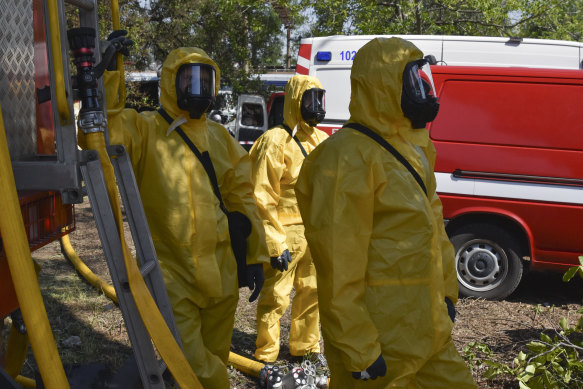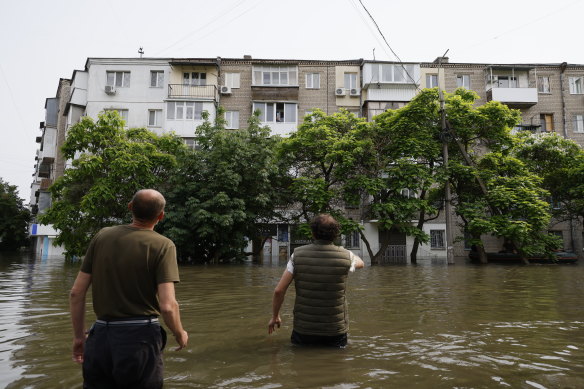
The high water could wash away this season’s crops, while the depleted Kakhovka reservoir would deny adequate irrigation for years. The reservoir’s loss also complicates any efforts to rebuild and restart the destroyed hydroelectric power station and ensure cooling water for any future attempts to restart the shut-down Zaporizhzhia Nuclear Power Plant.

Ukrainian emergency workers wearing radiation protection suits attend training in Zaporizhzhia, Ukraine, where Europe’s biggest nuclear plant relies in large part on water from the now-emptying reservoir at the Kakhovka dam. Credit: AP
A day after the dam’s collapse, the cause remained unclear, with both sides blaming each other. Some experts cited wartime damage and neglect, although others argued that Russia might have destroyed it for military reasons.
Either way, concluded analyst Michael Kofman, “Russia is responsible, either by virtue of action or by virtue of the fact that it controlled the dam.”
“It’s going to lead to lasting damage to agriculture, provision of drinkable water. And it’s going to wipe out entire communities,” Kofman — who is with the Centre for Naval Analyses, a US research group — told “PBS NewsHour.”
Many residents had fled the region because of the fighting, but clear estimates of those remaining weren’t available.
Ukrainian President Volodymyr Zelensky met with officials on how to provide drinking water to residents, as well as assess damage to wetlands, farms and other property from what he called “a crime of ecocide” and “a man-made strike on the environment, after which nature will have to recover for decades.”

Volunteers offer evacuation for the local residents of a building in Kherson, Ukraine. Credit: Getty
Speaking in English in a video posted on YouTube, Zelenskyy said it was impossible to predict how much of the chemicals and oil products stored in flooded areas will end up in rivers and the sea.
Ukraine’s agriculture ministry warned, “The fields in the south of Ukraine next year can turn into deserts.”
In the Moscow-controlled city of Oleshky, Lera, 19, told The Associated Press the first floor of her home was flooded.
Loading
“Everything around us is floating. People are standing on rooftops and asking for help, but no one is evacuating them,” said Lera, who declined to give her last name for fear of reprisals.
Most Russian troops fled Oleshky shortly after the dam incident, Lera said, although a military checkpoint remains, and boats with people trying to leave have come under fire from soldiers. Her claim couldn’t be independently verified.
Mayor Yevhen Ryschuk, who left the city after the Russians took control last year, reported three dead and said hundreds of residents need to be evacuated from their roofs. He said 90 per cent of Oleshky is flooded and facing a humanitarian crisis without electricity, potable water and food, as well as possible groundwater contamination.
Animals weren’t spared, with some pets trapped. Officials said the Kazkova Dibrova Zoo in Nova Kakhovka was under water and that “only swans and ducks could escape.” Leontyev said the flooding killed thousands of animals in a nature preserve.
Hundreds of animals trapped in Oleshky require urgent rescue, volunteers helping a local shelter told the AP.
Civilians in the city of Kherson clutched personal belongings as they waded through knee-deep water or rode rubber rafts. Video showed rescuers carrying people to safety, and what looked like the triangular roof of a building floating downstream.
Aerial footage showed flooded streets in the Russia-controlled city of Nova Kakhovka on the eastern side of the Dnieper, where Mayor Vladimir Leontyev said that seven people were missing, although believed to be alive.
In his first public comments on the disaster, Russian President Vladimir Putin repeated Moscow’s line that Ukraine is to blame for destroying the Kakhovka dam.
Loading
In a call with Turkish President Recep Tayyip Erdogan, Putin alleged that Kyiv authorities had escalated “war crimes, openly using terrorist methods and staging acts of sabotage on Russian territory,” the Kremlin said in its account of the call.
It was unclear how the dam disaster would affect the war and Ukraine’s counteroffensive against Russian troops. Artillery booms served as background to rescue efforts as people scrambled to leave the danger zone.
Kofman, the analyst, said he didn’t think the dam collapse “will substantially affect Ukrainian military prospects when it comes to their offensive this summer.”
“When you look at the situation along the Dnieper River — on the one hand, the flooding is going to damage the defences that the Russian military built alongside the riverbank,” he told PBS. “On the other hand, it’s going to make a Ukrainian cross-river operation exceedingly difficult.”
Addressing blame, the Institute for the Study of War, a Washington think tank, said Russia has “a greater and clearer interest in flooding the lower Dnieper despite the damage to their own prepared defensive positions.”
With some indications emerging that Ukraine might already have begun its long-anticipated counteroffensive, the ISW said Russian forces may think breaching the dam could cover a possible retreat and delay Ukraine’s campaign.
Experts noted that the 1950s-era dam, about 70 kilometres to the east of the city of Kherson, was believed to be in disrepair and vulnerable to collapse because water was already brimming over when the wall gave way. It hadn’t been producing power since November, according to officials.
The UK Defence Ministry said the Kakhovka reservoir was at record high levels before the breach and that the dam “is likely to deteriorate further over the next few days, causing additional flooding.”
The scale of the damage to the dam was unknown, but officials hoped to rebuild the complex once the Russians leave, said Ihor Syrota, general director of the Ukrainian national hydroelectric company Ukrhydroenergo. Workers, meanwhile, are holding water in other upstream reservoirs to compensate in part for the loss of the dam, he said.
Wheat and corn prices spiked Tuesday on fears over Ukraine’s ability to ship grain to developing nations where people are struggling with hunger and high food prices. Prices stabilised Wednesday.
AP
Get a note directly from our foreign correspondents on what’s making headlines around the world. Sign up for the weekly What in the World newsletter here.



























